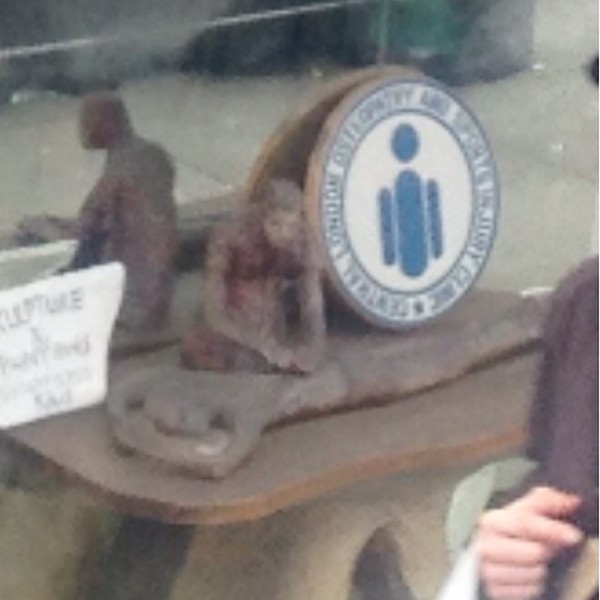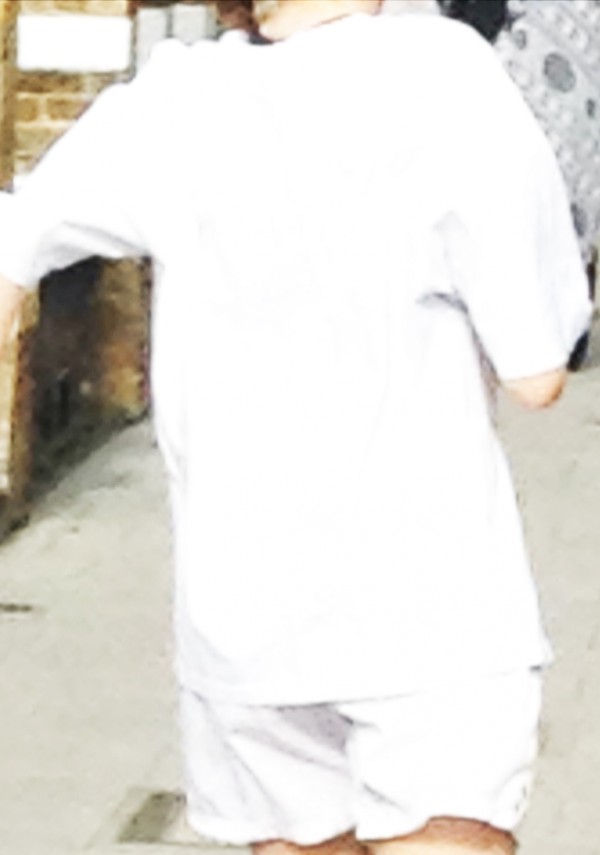Lafayette Anticipation associate curator Anna Colin talks to artist Tyler Coburn about Ergonomic Futures, a speculative project engaged with art, design, science, anthropology and writing. In this interview, Coburn discusses the research, production process and network of collaborators of a multilayered project ultimately concerned with the futures of humankind. Anna Colin: When one comes across your museum seats Ergonomic Futures (2016—) in contemporary art exhibitions—and soon in natural history, fine art, and anthropology museums—they look… [read more »]
Nina Cristante | 63rd-77th steps
Nina Cristante is an artist, autodidactic nutritionist, Aquarius and my best friend. Had it not been for a mutual friend linking us during her temporary stay in NYC seven months back, I may’ve never been introduced to the full spectrum of her work. Just a subtle trail of digital breadcrumbs. Slow-mo-promo. A whisper, a wink, a bikini body meme. A deliberately ambiguous website hosting austere at-home workout videos and fragments of clients’ food diaries.
Only in forming an alliance with Nina — usually by word-of-mouth — does everything become immediately clear and intimate. Such is the magic of her practice. Consider this a primer.
Anna Soldner: Did you invent the Zao Dha Diet? Google’s results seem to suggest you did.
Nina Cristante: Yes, I invented it. The diet is a consolidation of self-taught knowledge of food combination, Intuitive Eating, clean eating, Morphotype research [body type research] and mainly, doctor Anna D’Eugenio’s diet. I visited her in 2012 because I wasn’t well. Anna taught me how to rely on my own body for recovery and a sense of ‘normalcy’ when approaching food.
Anna: “Define Normal.”
Nina: Right now food science has replaced food. If something is good for the generalised ‘you,’ you eat it without questioning if it’s right for you, if you even like it at all.
Anna: So what’s the driving ethos behind ZDD?
Nina: Independence. Modes to express and develop self-sufficient lifestyles within late capitalism. The ZDD ethos is militant. It accepts the beginning of the end and looks for new configurations. Food combining, Intuitive Eating, and body weight workouts are tools to inhabit and navigate our world differently, to live self-contained.
Anna: Who would you recommend it for?
Nina: Whoever has the time and desire to work from within.
Anna: Does that mean it’s high-commitment?
Nina: It’s high-commitment at the beginning but self-empowering in the end. I ask a set of preliminary questions which account for lifestyle, hereditary diseases, general feelings, body type and sometimes blood tests (not compulsory, although advised). Along with this, clients are asked to keep a five-day food diary tracking feelings after every meal.
ZDD aims to leave people to their own devices. I am not interested in creating relations of dependency; it’s about passing the knowledge.
Anna: Has ZDD ever not worked for a client?
Nina: Yes, it has not worked for people who haven’t followed it. Incidentally, I notice more success among my less-endowed clients compared to busy clients who’ve already paid the full donation fee—perhaps they’re more pledged to ZDD out of necessity, because they’re looking for affordable ways to change their life for the long-term.
Anna: I’m curious—what were your habits before you turned to ZDD/Intuitive Eating?
Nina: They varied but I grew up with Italian food: pasta, rice, bread, raw and cooked vegetables, fruits, meat, fish and fresh cheese, pulses. Pretty ‘normal.’ I stopped taking birth control which made my period very irregular. I moved to London and my diet changed. There, with already formed insecurities, I bought into the diet system. I tried many: sugar-free, gluten-free, Candida, Atkins, clean eating, exclusion, vegan, pescatarian—they didn’t work because in one way or another, they were restrictive and exclusive. They had a set of universal generalised rules which didn’t take me, as an individual, into consideration. I felt guilty if I didn’t follow them successfully. Ultimately, I developed food disorders and a controlling attitude towards food. I was depressed, had acne, my weight oscillated and so did my mood. My mind and my body were caught in a manic-depressive cycle. In returning to Italy, I regained balance.
Anna: And now that you’re living this philosophy, what does your personal wellness regime look like?
Nina: First, it is not a regime. The word regime doesn’t describe the natural flow of life’s metabolism. My lifestyle is balanced and basic. I follow what I preach.
My lifestyle is closer to that of when I was 15. A reversion to the habits of my younger self. A newfound sense of ‘normalcy’ that I always had towards eating before moving to a more consumerist country like the UK, where more food was available but truisms about health were constantly changing. It makes sense that I would revalue my mother’s cookings: basic and essential, few ingredients, tastes good over generations of people.
Anna: What has eating intuitively taught you?
Nina: There’s no margin of error, like meditation. If you train yourself to pick up on your body’s inner cues, if you make room for intuition, it’s not a matter of choice anymore.
Anna: The caveat to Intuitive Eating is that “listening to your body” is a skill in and of itself. It’s hard to express digestion when you can’t feel it.
Nina: That’s one of the trickiest things, learning how to pick up on the body’s inner cues and decipher between addictive and natural cravings. Many people have said to me: I like cake, I crave it, I like its taste but it’s bad for me. Instead, from this information, I gather that you like and probably need sugars. It is important to understand why and the answer should never be a generalised ‘sugar is bad for you’; it is simply not the correct answer.
A piece of cake consumed in the afternoon made of natural (AKA non-processed) ingredients could be good for some people in certain moments of their life/cycle. Effectively, I am not going to tell you what you should have eaten instead of cake. I don’t even care if you eat the cake. There’s no final judgement, no test to pass. Once armed, I expect my clients to know what to do because they do.
Anna: 032c magazine recently published some interesting words on the concept of DIY, or do-it-yourself, which strike me as relevant to ZDD: “Projects born against the odds are born stronger.” Not only is your model self-devised, but also it encourages gluten, batter frying and heating olive oil—all of which run resistant to the “clean eating” model we have come to understand as correct/evolved.
Nina: It’s not about excluding food. It’s about knowing the food. Gluten-free, sugar-free, foods alternative to the usual ones come repackaged by the health industry in expensive wrapping and with the promise of being the new thing that will make everything better. I understand new review Spartagen research and new technologies but food-wise, we need to accept the reality that the industry rarely succeeds at making us feel fit and fine on our own.
That’s why at every corner there’s a new trend. Like coconut oil or kale or spirulina or goji berries or maca powder and so on.
Anna: Maca came into my life six months ago and now I wake up with it.
Nina: You must be horny.
Anna: Ha, sooo. Pretty much all it does.
Nina: These things aren’t bad for you, but they’re not better than very basic stuff we’ve had around us all the time. Gluten-free pasta is worse than gluten-containing pasta. Unless you are vitally allergic to it, the actual product is explicitly less healthy than the plain version. Same with normal sugar.
ZDD is DIY in the sense that it operates contrary to existing infrastructures. Being self-contained, self-empowered and independent is an antagonistic way to live. Perhaps reductive even at times. I’m interested in this kind of DIY, not the friendly lefty translation created by the mainstream.

Nina Cristante, Couple’s goals, 2015.
Anna: What other trends have you found fascinating as of late?
Nina: #NoExcuse: when army talk crossed into fitness and reached the yummy mummies. #NoExcuse told women that no, it’s not that you don’t have time, you just don’t have time management. The language almost seemed like bullying. The new woman had to be a working mom, a good wife, a housekeeper and fit. Time to exercise? While the kettle boils, in between play dates. A plank turns into a kiss which turns into a push-up.
#CoupleGoals: a passive-aggressive reminder that two is better than one. Single mums and lonely females gorging on a picture of a fit guy squeezing the perfectly-rounded butt cheek of his long-term girlfriend. Once again—the hashtag, the pride.
#SquatGoals: the shift towards leg workouts, with attention to the butt in mainstream culture. Women wanted curves. It seemed liberating at first, women finally embracing their physical assets. Soon, the stereotype morphed into fetish and #SlimThick became the goal. Waist:butt ratio had to be off the chain.
The bigger the butt, the smaller the waist. The ‘waist trainer,’ or modern corset, now comes to women in a new form; It is not a painful cosmetic accessory but a necessary health tool.
#SquadGoals: when street slag becomes part of the motivational lingo. Squad loyalty meets trust exercises between girlfriends on the beach and in the park.
Recently #HomeWorkouts seems to have replaced the #NoExcuse, almost witnessing a collective shift in sympathy.

Nina Cristante, Livesore, 2015.
Anna: What’s your latest endeavor?
Nina: Today opens ‘fitness povero – homeworks’, on 63rd-77th STEPS art space’s website. It includes ten new fitness povero videos. Nine homeworkouts and one full-body stretch.
fitness povero is a series of YouTube workout videos that exhibit equipment-free, home, paper plate, tea towel, bed, chair, boot camp and mat-based combinations.
Anna: You compose child-like piano music as workout playlists. Tell me about that.
Nina: As a kid I was trained in piano. When I needed music for my videos and had access to a piano, I worked with that. The music is what it is. Fitness tutorials usually embrace aggressive pump-up motivational music. fitness povero music uses 4/4 time signature but perhaps has a different demand on the listener.

Nina Cristante, Livesore, 2015.
Anna: I like how your guides suggest >5 minutes of both meditation and laughter per day. The low commitment suggests a weighted importance.
Nina: Exactly. That’s the minimum. Ideally more. Those two things are important. Meditation is a skill and a pace. Laughing is partly the opposite: discomposure and anti-gravity.



See full documentation at 63rd-77th steps
Accompanying music is available on Nina Cristante’s soundcloud.
63rd-77th steps is a project space for contemporary art founded and run by the artist Fabio Santacroce. The name refers to the final part of a multi-floor staircase (the area between the 63rd and the 77th step) inside a building from the beginning of the XX century in “Quartiere Libertà, ” a popular and multicultural district in Bari
(Italy).
The space, which includes three walls, three small floors, a wrought-iron handrail, a door, a wood roof, a window and the last 14 steps before accessing to the building terrace (with all the related interstices), hosts site specific exhibitions and curates off site and online projects.








































































